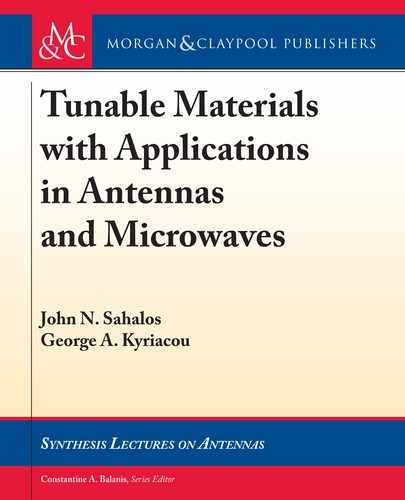
5.7. CHARACTERISTIC IMPEDANCE VS. FREQUENCY, Z
0
.f / 191
where
f
50
D
C tan
1
h
"
r
q
"
reff
.f D0/1
"
r
"
reff
.f D0/
i
2h
p
"
r
"
reff
.f D 0/
0:75 C Nw
0:75 0:332="
1:73
r
(5.23b)
m D m
0
m
c
2:32 (5.23c)
m
0
D 1 C
1
1 C
p
Nw
C 0:32
1 C
p
Nw
3
(5.23d)
m
c
D
8
<
:
1 C
1:4
1C Nw
0:15 0:235 e
0:45f =f
50
for Nw 0:7
1 for Nw 0:7:
(5.23e)
e above Kirschning and Jansen [16] and Kobayashi [20] expressions have an accuracy
of better than 0.6% for the single-layer microstrip.
5.7 CHARACTERISTIC IMPEDANCE VS. FREQUENCY,
Z
0
.f /
e frequency dependence of the characteristic impedance can be evaluated using COMPEL’s
formulae by Tounsi et al. [21]:
Z
0
.f / D Z
0
.f ! 0/
"
reff
.f / 1
"
reff
.f D 0/ 1
s
"
reff
.f D 0/
"
reff
.f /
; (5.24)
where Z
0
.f ! 0/ is the quasistatic characteristic impedance often found in [3] as a closed-form
expression, or is given in diagrams and alternatively defined in Eq. (5.15a).
5.8 DIELECTRIC LOSSES
e evaluation of the attenuation factor due to dielectric losses can be based on the complex
dielectric constant approach defined in (5.18). For this purpose, Verma et al. [15, 17, 18] adopt
Yamashita’s variational approach [5] in conjunction with the complex admittance function of
the transverse transmission line [19]. However, this is a rather complicated technique and is
restricted to a specific number of layers.
According to the classical microwave integrated-circuits handbook [3] and the original
references therein, an equivalent effective dielectric loss factor (tan ı
";eff
) can be defined for a
transversely inhomogeneous quasi-TEM line. is is given from a static approximation under
a low-loss condition, namely a small dielectric loss tangent tan ı
"
<< 1, and it reads:
tan ı
";eff
D q
tan ı
"
tan ı
"
; (5.25)
..................Content has been hidden....................
You can't read the all page of ebook, please click here login for view all page.
